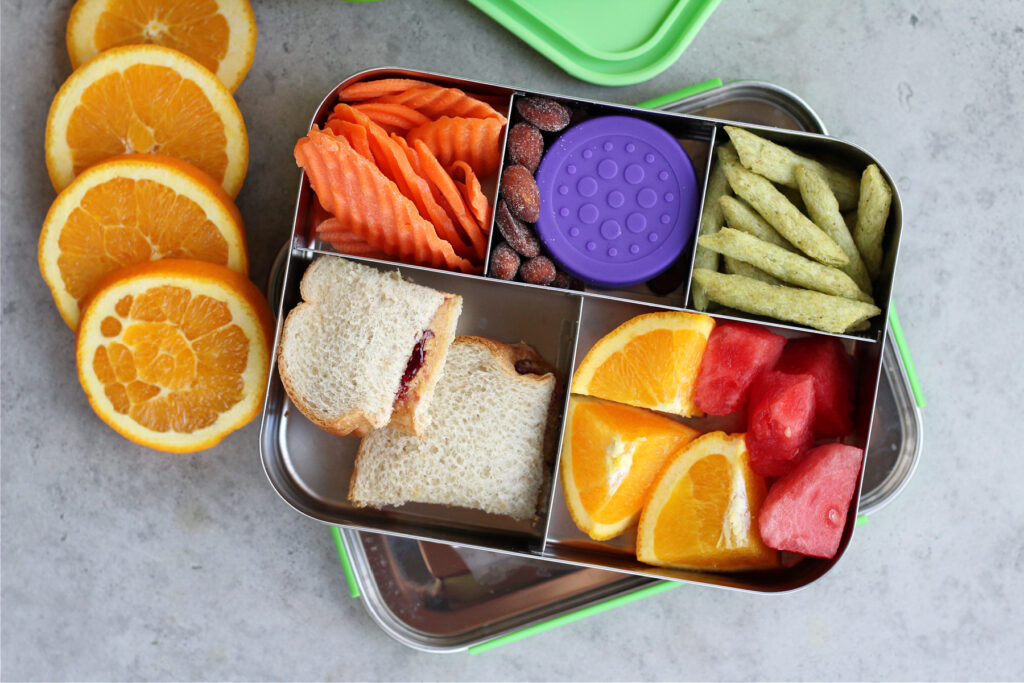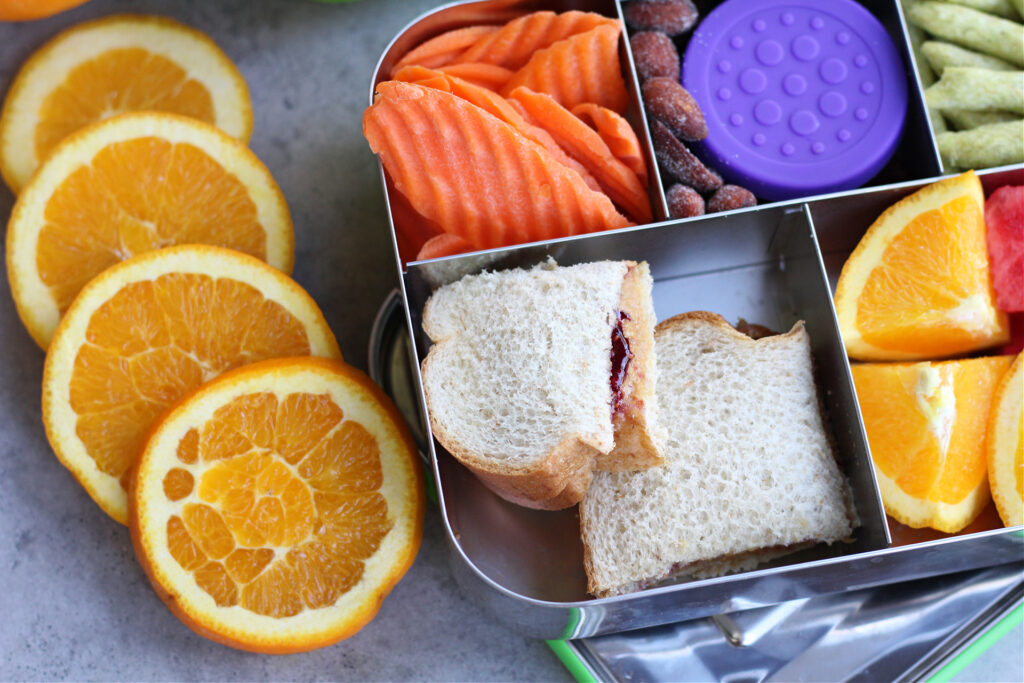Do you have a child in school? Do you work in the office? Or maybe you take your lunch to your desk at home everyday like me? It’s no secret that back to school time can be stressful for kids and us parents….the schedule change is enough to make just about everyone pull their hair out. Not to mention the meal planning (breakfast, lunch and dinner!) and the start of school sports again.
So, are you looking for an easy way to tackle some of that meal planning? Want a nutritious meal for the kids that is actually easy to pack? Build a bento box lunch! Actually, they are also perfect for breakfast on-the-go and snack time 😉 Yes, I am speaking from personal experience.
Building a bento box involves assembling a well-balanced meal in a compact container. Traditional Japanese bento boxes typically consist of rice, protein, vegetables, and a variety of side dishes, however they have evolved to include a variety of nutritious options that have a protein, veggies, fruit and typically a snack.

Here’s a step-by-step guide on how to build a basic bento box:
- Start with a good Bento Box: Choose a bento box that suits your needs. There are various sizes and styles available, including silicone boxes, plastic boxes, and stainless steel designs all with multiple compartments.
- Protein: Select a source of protein. A few options are: PB&J, Turkey sandwich, hard-boiled egg, grilled chicken from last night’s dinner…
- Vegetables: Add a variety of colorful vegetables for both nutrition and aesthetics. We love the carrot chips as they are perfect for dipping.
- Fruit: We love adding navel oranges to our bento boxes. Noble Select Sweet Navel oranges are simple and delicious. You can peel them or simply slice them or segment them and add them to your bento box. Not only do oranges taste great, but they are rich in nutrients such as vitamin C, vitamin C. fiber, antioxidants, and folate. All of which will help your immunity and fighting off those back to school colds.
- Snack: Pretzels, almonds, trail mix. Whatever will make your child smile.
- Dip: Include small container of dip. Ranch and hummus are always popular choices for veggies 😉

Remember that bento boxes are highly customizable, so feel free to adjust the ingredients and portion sizes to suit your child’s preferences and dietary restrictions. Have fun experimenting with different combinations to create your perfect bento box! In fact, building a bento box is the perfect opportunity to get your kids involved in the kitchen. If kids have a hand in packing lunch, they are more likely to eat what’s in it.
Packing a well-balanced and appealing lunch for kids is important to ensure they get the nutrition they need and actually enjoy their meals. Be sure to try to strike a balance between providing healthy options and the occasional treat to keep lunchtime exciting for your child.

Here are some ideas for what to pack in kids’ lunches:
Sandwiches and Wraps:
Peanut butter and jelly or almond butter and fruit spread.
Turkey and cheese.
Ham and Swiss cheese.
Chicken or tuna salad.
Hummus and veggies in a wrap.
Cream cheese and cucumber.
Fruits and Vegetables:
Oranges. Slices, segments or peeled. Anyway you serve em, kids will be excited to see em!
Carrots and cherry tomatoes with ranch dressing.
Sliced cucumbers or bell peppers.
Fruit kabobs.
Dairy and Dairy Alternatives:
Yogurt cups (choose ones with lower sugar content).
Cheese sticks or cubes.
Milk or a dairy-free alternative like almond milk.

Proteins:
Hard-boiled eggs.
Sliced deli meats (turkey, chicken, or roast beef).
Mini meatballs or chicken nuggets.
Veggie nuggets (if your child prefers plant-based options).
Grains and Carbohydrates:
Whole-grain bread or wraps.
Mini bagels with cream cheese.
Whole-grain crackers with cheese.
Rice cakes or whole-grain rice.
Mini muffins or granola bars (choose ones with lower sugar content).
Treats and Snacks:
Trail mix with nuts, dried fruits, and a few chocolate chips.
A small piece of dark chocolate.
Homemade or store-bought popcorn.
Fruit leather or fruit snacks (choose ones with no added sugars).
A small portion of cookies or a granola bar.
Something To Drink:
Include a bottle of water, a juice box, and/or milk.

Now that your lunch is packed and ready to go, how about some more ideas on how to enjoy those Noble Navel Oranges? We love just slicing em up and eating them, but there are so many more ways to enjoy oranges…here’s a few of our favorites:
- Segment the oranges and add them to fruit salads for a burst of citrus flavor.
- Squeeze navel oranges to make fresh orange juice.
- Use them in smoothies or cocktails.
- Grate the zest of navel oranges and add it to baked goods, salads, or marinades for a citrusy kick.
- Sprinkle orange slices with a pinch of cinnamon or a drizzle of honey for a delightful twist.
- Layer orange segments with yogurt and granola for a refreshing and nutritious breakfast or snack.
- Dice navel oranges and mix them with diced red onion, jalapeño, cilantro, lime juice, and a pinch of salt. Serve it as a topping for grilled chicken or fish.
- Add orange slices to a pitcher of water for a refreshing and lightly flavored drink.









